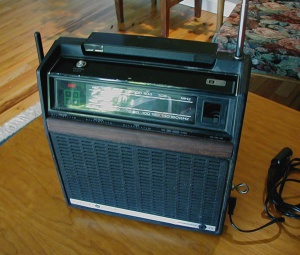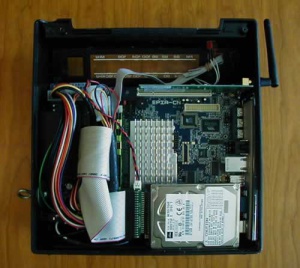8track
My quest for low power systems began in my Carbon diet page and now it continues with this system.
Origin of the name 8track. When I was riding around Corvallis one day, I saw a pile of free stuff in front of someone's house. Right on top was a GE portable AM/FM 8 track player. I could not pass it up. I envisioned putting a computer in the case and that is what I did.
I realize now that I could probably have sold it for $10 on Ebay! Well, I have gotten more than $10 worth of entertainment out of it so far.
I used 8track as the unofficial Solar CREEK kiosk at DaVinci Days 2006. It ran off solar power all day playing a video and allowing access to the Solar CREEK Web site.
Hardware specs
"8track" is complete computer system based on a Via CN10000 Mini-ITX board inside a GE 8 track player case.
8track currently has
- Via CN10000 C7 mainboard
- 1GB RAM
- 32GB Patriot solid state SATA drive
- Wifi PCI card based on Broadcom chipset
Just added: PicoLCD from http://mini-box.com/ The PicoLCD should be able to support 5 LED's that will be inserted into the 8 track case "stereo" and "track" indicators. It should also support some push buttons if I find a place to mount them.
I'd also like to hook up the tuner knob to a digital encoder. Who knows when I will get around to that!
The first version of 8track used a Via EPIA 800. The C7 is faster and uses less power.
It had a 60W Morex automotive power supply which died when it was less than a year old. For a few years I used this Casetronic case and am currently using its power supply.
The Morex supply allowed 8-24V input. It was supplied with a separate DC-DC regulator. I bought it from Logic Supply, this link might not work any more. Morex automotive power supply At the Solar CREEK booth at DaVinci Days, I ran it on a solar panel and a 120 vac inverter. The inverter powered a 12V DC brick, the 120V Acer LCD monitor, and a pair of powered speakers.
Currently an old HP Omnibook 800 laptop mobile adapter is being used as the DC-DC regulator in front of the Casetronic supply (which also takes 12V in). This should be fine in an automotive environment.
Disk storage: Originally I used the 2.5" drive because the Morex did not support the power requirements of a 3.5" drive on its 12V output.I used a Toshiba 4200 rpm 30GB drive (PATA) plugged into a 44-40 pin adapter. Later I went to a Seagate 80GB 7200rpm SATA drive. Currently I am using a Patriot 32GB SSD. This SSD is probably a step DOWN from the Seagate, its performance is not very good; but it's a better choice for an automotive environment.
The original C3 set up with 4200rpm hard drive took about 10 watts at its 12V input. I need to take measurements on the new configuration.
Main board
I bought the CN10000EG fanless C7 board from Logic Supply.
The CN10000 board worked quite well as a server, I used it for about a year as my home server / firewall. I replaced it with an Intel Atom server Bellman. The C7 did not have enough juice to run the Java Netbeans IDE and the video drivers were not up to snuff for Ubuntu 7.04 Hardy Heron.
Maybe the video chip itself WOULD work but the drivers don't support the high end Gnome features. I am not sure. I wish that Via did more work to support their products or at least open them up. They put dandy hardware like graphics and media decoder and encryption chips on the board then do not provide up-to-date Linux drivers for them.
I got my EPIA C3 800 Mhz mainboard from Logic Supply, too. It has since died. I abused it when moving it from case to case, static probably got it.
Some specs:
VIA CN700 north bridge VIA VT8237R south bridge LAN: VIA VT6103 10/100 AUDIO: VIA VT1618 8 channel AC'97 codec Keyboard: Apple Bluetooth HID
File:CN10000.pdf PDF manual
C7 kernels
As I rebuild this system for its new automotive application, I tested Ubuntu 10.10 and found none of the i386 options will run. Applications crash randomly. I think it's probably using a 686 build that includes instructions not supported by the C7 processor.
I am using Debian 5.0 now and it works just fine.
I ran early versions of Ubuntu by compiling a C7 kernel. For posterity, here are my C7 kernel build notes.
http://www.howtoforge.com/kernel_compilation_ubuntu_p2?s=2e4e7db1d3b0009a48132ba132e72f9e&
make-kpkg clean fakeroot make-kpkg --initrd build kernel_image kernel_headers modules
This builds the packages up one layer, you have to go there and install them.
cd .. sudo dpkg -i packagename ..and so on
Software
Oct 18 2010 -- I am currently figuring out what to include so I need to update this section.
I used netboot to install the basic Debian 5 plus the laptop stuff, because I always seem to end up with worn out CD players at home! After the basic install I added these packages:
- aprsd (not sure about this one yet)
- gpsd (for kismet and foxtrotGps)
- kismet (for wifi searching. this pulls in lots of other packages)
- openssh-server (for logging in from the laptop at the kitchen table)
- xfce -- the compact desktop environment
- vlc -- a media player
There will be some kind of music playback system. I installed vlc for now. This system will not be used for video playback, it's in a car!
The keyboard
One of my least favorite Garmin nuvi features is the on-screen keyboard. 8track now has an Apple Bluetooth keyboard.
Log into 8track via ssh (since it has no keyboard right now) Turn on the Apple keyboard. Scan the airwaves:
bwilson@8track:~$ hcitool scan Scanning ... E8:06:88:4F:52:48 Apple Wireless Keyboard
Add the configuration to /etc/bluetooth/hcid.conf
device E8:06:88:4F:52:48 {
name "Apple Wireless Keyboard";
auth enable;
encrypt enable;
}
bwilson@8track$ sudo bluetooth restart
Thanks to http://ubuntuforums.org/showthread.php?t=224673 for figuring this out. That page lists several additional steps, Debian and or the keyboard did not require them.
The navigation software will be based on FoxtrotGPS. Since I plan on writing code I am downloading the source from there. I added the packages required to build it; more information is on my page here: foxtrotGps.
Pictures

A wood strip is fitted to cover over empty slots left when I removed the various controls (volume, tone and so on.) It fits the style of cases of this vintage though it's real hardwood not contact paper!

Here you can see the interior layout. The Seagate PATA drive has been replaced with a Patriot SSD SATA drive.
There is now a PicoLCD 20x2 LCD mounted in the tuner display area. The Wifi card fit in easily once I removed its card slot adapter.
I used a router* to enlarge the 8-track slot to fit the mainboard back panel. The styrene plastic is very easy and clean to work with a carbide bit. I probably won't get cancer for many more years.
The large metal ring on the left is an eye bolt to allow me to lock down the case when I leave it unattended in public places. It has been removed now, replaced with a power on/off push button.
* Def router: a motor with a spinning cutter attached, not a network device.